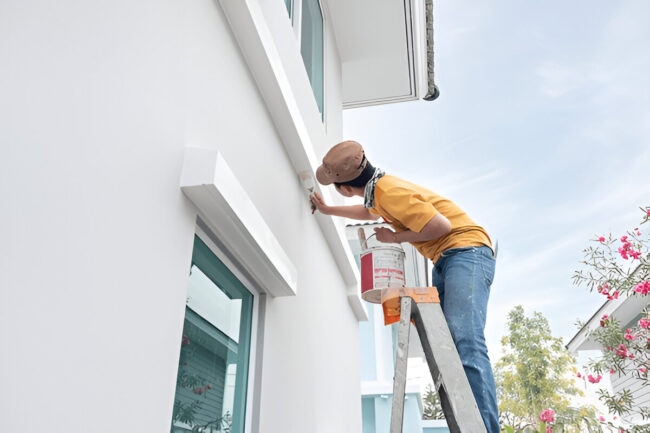
As more homeowners embrace sustainable living, the choices we make for home maintenance are evolving. One significant decision—often overlooked in environmental conversations—is the kind of paint used on the exterior of a home. In cities like Toronto, where seasonal extremes can take a toll on building materials, selecting an eco-friendly paint isn’t just good for the environment—it’s a smart investment in long-lasting curb appeal.
Whether you’re revamping a century-old Victorian in Cabbagetown or refreshing a modern home in the Beaches, choosing a green exterior paint that performs in Canada’s unique climate can make all the difference. And with more professionals offering exterior painting Toronto services that prioritize sustainability, the shift is becoming easier than ever.
What Makes a Paint Eco-Friendly?
Eco-friendly exterior paints are defined by their low environmental impact. Typically, they contain little to no volatile organic compounds (VOCs)—chemicals that evaporate into the air and contribute to air pollution and health issues. These paints are also manufactured through environmentally conscious processes and are often packaged in recyclable or biodegradable containers.
Some brands go even further by sourcing natural ingredients like clay, plant oils, and mineral pigments. Others rely on water-based formulas that reduce both emissions and cleanup waste. When comparing products, look for certifications like Green Seal, LEED compliance, or labels indicating “zero VOC” or “low VOC.”
Why VOCs Matter—Especially in Urban Neighbourhoods
Toronto’s dense neighbourhoods mean that painting projects affect more than just one household. VOCs contribute to smog formation and indoor air quality issues, and when used in outdoor painting, they can linger in the air for days. For families, pets, and those with respiratory conditions, minimizing VOC exposure is essential.
Choosing low-VOC or zero-VOC paints significantly reduces these risks. Some modern paints even include antimicrobial properties, which help protect your exterior walls from mildew and mould growth—an especially important consideration in a climate that ranges from humid summers to wet, slushy winters.
Performance Without Compromise
One of the biggest misconceptions about eco-friendly paint is that you have to trade performance for sustainability. Today’s green paints are engineered to withstand extreme weather, resist fading, and maintain strong adhesion—critical qualities for any home in Toronto’s fluctuating climate.
Look for options with UV protection, mildew resistance, and flexible film technology that expands and contracts with seasonal temperature changes. These attributes extend the life of the paint and reduce the need for frequent touch-ups, which in turn lessens your long-term environmental impact.
Popular Eco-Friendly Paint Types for Exteriors
- Water-Based Acrylics: These are among the most popular low-VOC options, offering excellent durability and colour retention.
- Natural Paints: Made from ingredients like milk protein, lime, or clay, these are ideal for heritage homes but may require more maintenance.
- Recycled Paints: Some companies reclaim and reprocess leftover paints to create new blends—perfect for budget-conscious and eco-conscious homeowners.
Climate Considerations in Paint Selection
Toronto’s four-season weather makes durability a top priority. When selecting an eco-friendly paint, check the label for temperature application ranges and freeze-thaw resistance. Water-based paints, for instance, should only be applied when temperatures are above 10°C to ensure proper adhesion.
Humidity also plays a role. Choose paints with fast-drying technology if you’re planning a summer project, as sudden rainstorms or high dew points can compromise curing.
Surface Preparation for Long-Lasting Results
Even the best eco-friendly paint will fail without proper preparation. Ensure surfaces are clean, dry, and free from peeling paint or mildew before application. Use biodegradable cleaning solutions or pressure washers with water-saving attachments to keep the prep work sustainable as well.
For older homes, be cautious of lead-based paint under existing layers—especially if your home was built before 1978. Hire certified contractors trained in safe removal and disposal practices if needed.
Complementing Toronto’s Architectural Styles
Eco-friendly paint options now come in a wide array of colours, finishes, and sheens. Whether you’re updating a red brick semi-detached in the Annex or modernizing a detached house in Etobicoke, there are sustainable options to suit every design aesthetic.
Flat and eggshell finishes are popular for exterior siding as they offer a more traditional, breathable look, while semi-gloss is ideal for trim and shutters due to its moisture resistance and washability.
Additional Ways to Make Your Painting Project Sustainable
- Reuse or donate leftover paint: Many recycling programs accept partial paint cans.
- Choose local suppliers: This reduces the carbon footprint associated with transportation.
- Use high-quality brushes and rollers: These last longer and reduce microplastic shedding compared to cheap alternatives.
Where to Find Green Painting Professionals
As demand for sustainable practices grows, more painters are embracing environmentally responsible methods. When searching for a contractor, ask about their eco-friendly product lines, waste disposal practices, and experience working with non-toxic materials.
You’ll also want to ensure they understand the nuances of exterior painting Toronto homes—where weather, heritage restrictions, and material types play a major role in planning a successful project.
Fresh Coat, Greener Choice
Opting for eco-friendly exterior paint isn’t just about going green—it’s about making thoughtful decisions that protect your home, your health, and the environment. With more low-VOC and high-performance options on the market, sustainable exterior painting is no longer a compromise—it’s a smart, forward-thinking choice for Toronto homeowners.
